parking sensors Lancia Delta 2011 Owner handbook (in English)
[x] Cancel search | Manufacturer: LANCIA, Model Year: 2011, Model line: Delta, Model: Lancia Delta 2011Pages: 290, PDF Size: 8.36 MB
Page 6 of 290
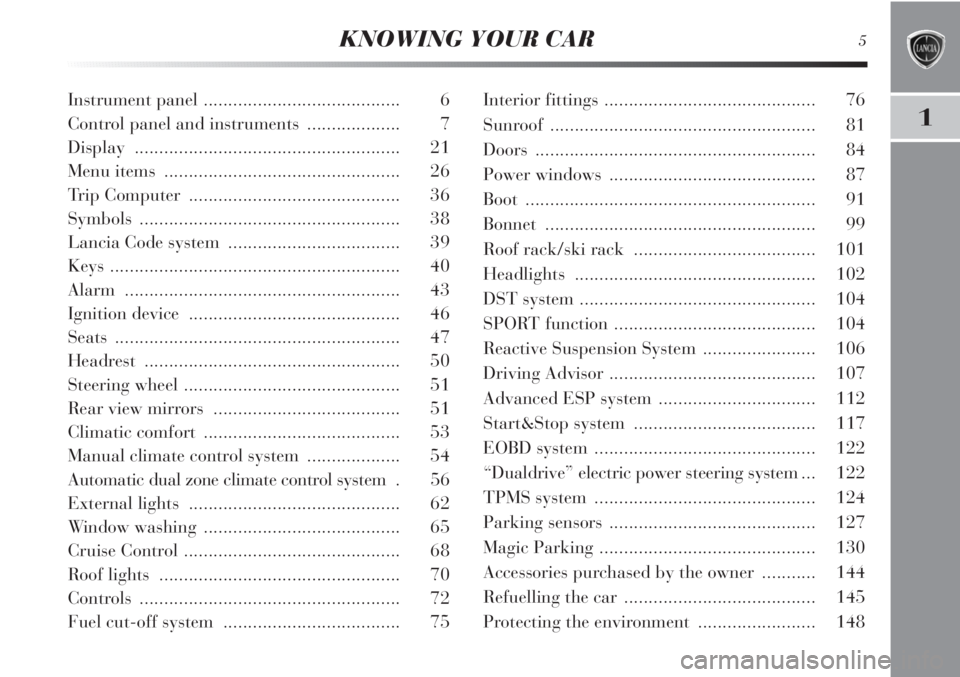
KNOWING YOUR CAR5
1
Instrument panel ........................................ 6
Control panel and instruments ................... 7
Display ...................................................... 21
Menu items ................................................ 26
Trip Computer ........................................... 36
Symbols ..................................................... 38
Lancia Code system ................................... 39
Keys ........................................................... 40
Alarm ........................................................ 43
Ignition device ........................................... 46
Seats .......................................................... 47
Headrest .................................................... 50
Steering wheel ............................................ 51
Rear view mirrors ...................................... 51
Climatic comfort ........................................ 53
Manual climate control system ................... 54
Automatic dual zone climate control system . 56
External lights ........................................... 62
Window washing ........................................ 65
Cruise Control ............................................ 68
Roof lights ................................................. 70
Controls ..................................................... 72
Fuel cut-off system .................................... 75Interior fittings ........................................... 76
Sunroof ...................................................... 81
Doors ......................................................... 84
Power windows .......................................... 87
Boot ........................................................... 91
Bonnet ....................................................... 99
Roof rack/ski rack ..................................... 101
Headlights ................................................. 102
DST system ................................................ 104
SPORT function ......................................... 104
Reactive Suspension System ....................... 106
Driving Advisor .......................................... 107
Advanced ESP system ................................ 112
Start&Stop system ..................................... 117
EOBD system ............................................. 122
“Dualdrive” electric power steering system ... 122
TPMS system ............................................. 124
Parking sensors .......................................... 127
Magic Parking ............................................ 130
Accessories purchased by the owner ........... 144
Refuelling the car ....................................... 145
Protecting the environment ........................ 148
Page 16 of 290
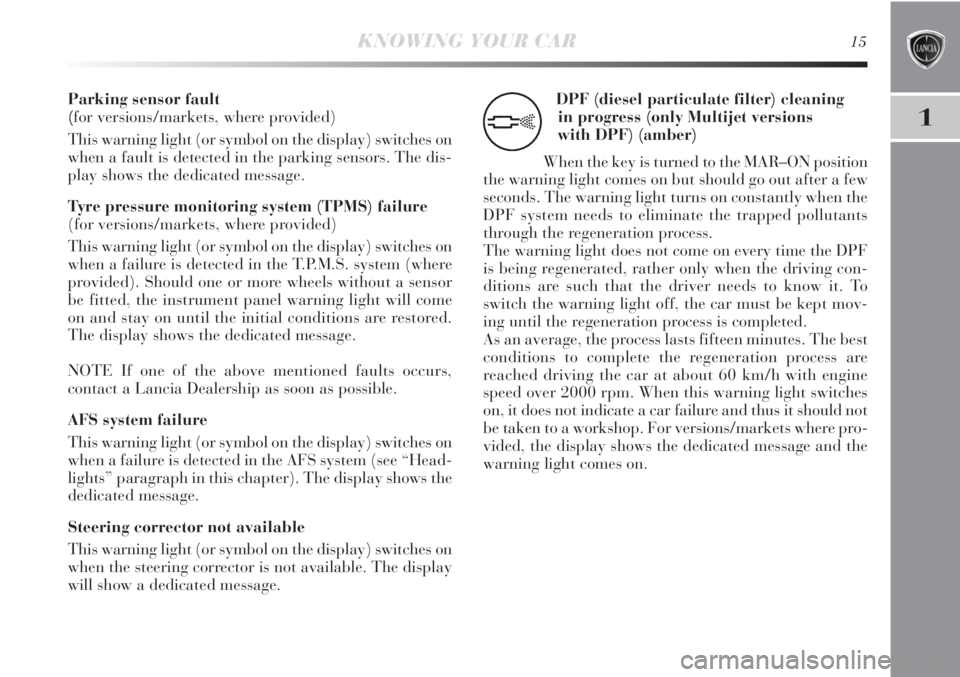
1
KNOWING YOUR CAR15
Parking sensor fault
(for versions/markets, where provided)
This warning light (or symbol on the display) switches on
when a fault is detected in the parking sensors. The dis-
play shows the dedicated message.
Tyre pressure monitoring system (TPMS) failure
(for versions/markets, where provided)
This warning light (or symbol on the display) switches on
when a failure is detected in the T.P.M.S. system (where
provided). Should one or more wheels without a sensor
be fitted, the instrument panel warning light will come
on and stay on until the initial conditions are restored.
The display shows the dedicated message.
NOTE If one of the above mentioned faults occurs,
contact a Lancia Dealership as soon as possible.
AFS system failure
This warning light (or symbol on the display) switches on
when a failure is detected in the AFS system (see “Head-
lights” paragraph in this chapter). The display shows the
dedicated message.
Steering corrector not available
This warning light (or symbol on the display) switches on
when the steering corrector is not available. The display
will show a dedicated message.DPF (diesel particulate filter) cleaning
in progress (only Multijet versions
with DPF) (amber)
When the key is turned to the MAR–ON position
the warning light comes on but should go out after a few
seconds. The warning light turns on constantly when the
DPF system needs to eliminate the trapped pollutants
through the regeneration process.
The warning light does not come on every time the DPF
is being regenerated, rather only when the driving con-
ditions are such that the driver needs to know it. To
switch the warning light off, the car must be kept mov-
ing until the regeneration process is completed.
As an average, the process lasts fifteen minutes. The best
conditions to complete the regeneration process are
reached driving the car at about 60 km/h with engine
speed over 2000 rpm. When this warning light switches
on, it does not indicate a car failure and thus it should not
be taken to a workshop. For versions/markets where pro-
vided, the display shows the dedicated message and the
warning light comes on.
h
Page 128 of 290

1
KNOWING YOUR CAR127
PARKING SENSORS
(for versions/markets where provided)
The parking sensors are located on the rear bumper fig.
80 and their function is to inform the driver, through an
intermittent beeping, of the presence of obstacles behind
the car.
ACTIVATION/DEACTIVATION
The sensors are automatically activated when the reverse
gear is engaged. As the obstacle behind the vehicle gets
closer to the car, the buzzer becomes more frequent.
fig. 80L0E0059m
BUZZER WARNING
When reverse gear is engaged and there is an obstacle be-
hind the car a buzzer is activated and the signal varies
as the distance of the obstacle from the bumper varies.
The beep frequency:
❍increases as the distance between the car and the ob-
stacle decreases;
❍becomes continuous when the distance between the
car and the obstacle is less than around 30 cm and
stops immediately if the distance increases;
❍is constant if the distance is unchanged.
Detection distances
Centre operating radius 140 cm
Side operating radius 60 cm
If several obstacles are detected by the sensors, only the
nearest one is considered.
Page 129 of 290

128KNOWING YOUR CAR
FAILURE INDICATIONS
Any faults in the parking sensor system are indicated,
when reverse gear is engaged, by the
èwarning light on
the instrument panel lighting up and a dedicated message
appearing in the multifunction display.
OPERATION WITH TRAILER
Sensor operation is automatically deactivated when the
trailer’s electric cable plug is fitted in the car’s tow hook
socket.
The sensors are automatically reactivated when the
trailer’s cable plug is removed.
For correct operation, sensors must always
be clean from mud, dirt, snow or ice. Be
careful not to scratch or damage the sensors
while cleaning them. Avoid using dry, rough or
hard cloths. The sensors should be washed using
clean water with the addition of car shampoo if
necessary. When using special washing equipment
such as high pressure jets or steam cleaning, clean
the sensors very quickly keeping the jet more than
10 cm away.
GENERAL WARNINGS
❍When parking, watch out for obstacles that may
be above or under the sensors.
❍Sometimes, objects placed close to the car are not de-
tected and could therefore cause damage to the car
or be damaged themselves.
The following conditions may influence the performance
of the parking sensor system:
❍Reduced sensor sensitivity and a reduction in the
parking assistance system performance could be due
to the presence on the surface of the sensor of:
ice, snow, mud, thick paint.
❍The sensor may detect a non-existent obstacle (echo
interference) due to mechanical interferences, for ex-
ample when washing the vehicle, rain (strong wind),
hail.
Page 130 of 290
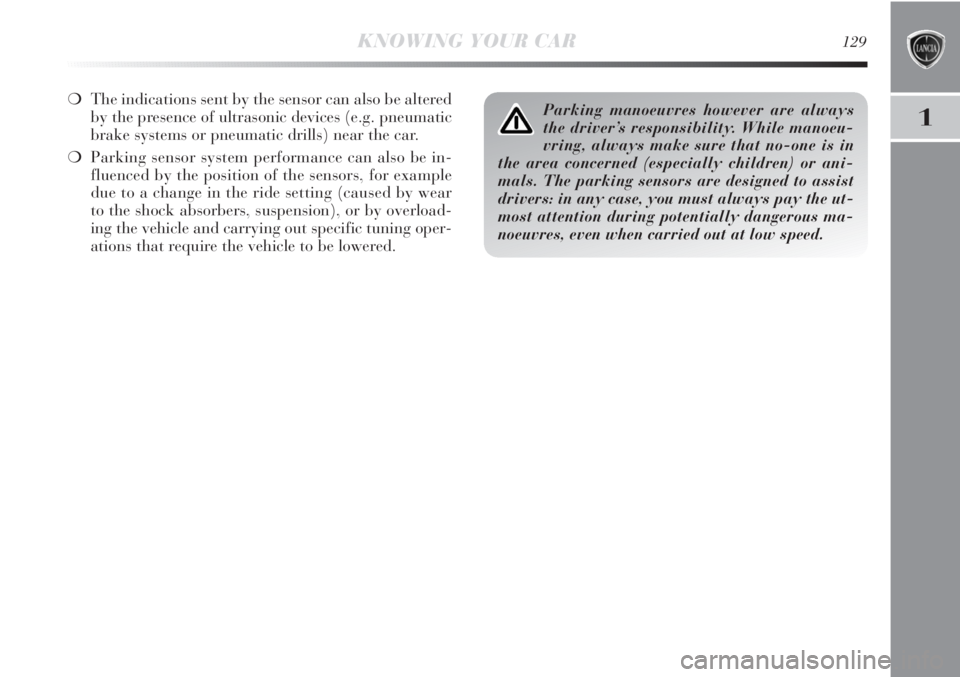
1
KNOWING YOUR CAR129
❍The indications sent by the sensor can also be altered
by the presence of ultrasonic devices (e.g. pneumatic
brake systems or pneumatic drills) near the car.
❍Parking sensor system performance can also be in-
fluenced by the position of the sensors, for example
due to a change in the ride setting (caused by wear
to the shock absorbers, suspension), or by overload-
ing the vehicle and carrying out specific tuning oper-
ations that require the vehicle to be lowered. Parking manoeuvres however are always
the driver’s responsibility. While manoeu-
vring, always make sure that no-one is in
the area concerned (especially children) or ani-
mals. The parking sensors are designed to assist
drivers: in any case, you must always pay the ut-
most attention during potentially dangerous ma-
noeuvres, even when carried out at low speed.
Page 131 of 290

130KNOWING YOUR CAR
The ultimate responsibility when parking,
however, always rests with the driver. Dur-
ing the entire manoeuvre it it always neces-
sary to make sure that there are no people or ani-
mals in the space.
Parking sensors are a driving aid for the
driver, who should continuously pay atten-
tion to all potentially dangerous manoeu-
vres, even at low speed: the Magic Parking system
DOES NOT adjust the vehicle speed in manoeu-
vres; the control of the acceleration speed and
braking remain the responsibility of the driver.
MAGIC PARKING
(for versions/markets where it provided)
The Magic Parking system notifies the driver of a free
parallel parking space that is a suitable length for the ve-
hicle; it helps the driver when manoeuvring by automat-
ically managing the movement of the steering wheel.During the manoeuvre the driver is also assisted by in-
formation from the parking sensors (4 front and 4 rear)
which provide further distance information when ap-
proaching obstacles in front of and behind the vehicle.
When looking for a parking space it is helpful if the front
and rear sensors are not activated, whilst during the ma-
noeuvre, the front and rear sensors will be automatically
activated when reverse gear is engaged.
Page 132 of 290

1
KNOWING YOUR CAR131
SENSORS
While searching for a parking place, the system uses side
sensors (see fig. 81).
These sensors are automatically activated below around
30 km/h; during this stage if the driver has just passed
a space that might be useful for a manoeuvre, the func-
tion can be requested using the special button; at this
point the instructions for carrying out the manoeuvre will
be shown on the display. If the function is not requested
by the driver using the special button, no information will
be displayed on the instrument panel.OPERATION
The assisted parking manoeuvre can only be activated
with the instrument panel on and at speeds below about
30 km/h and is divided into the following stages:
❍Activation: pressing the button fig. 82 activates the
search stage.
❍Search: through side sensors, the system continuously
searches for a free parking space, suitable to the vehicle
dimensions. The driver determines on which side of the
road they intend to park using the direction indicators (if
no information is available from the direction indicators
or hazard warning lights, the search takes place on the
passenger side).
IMPORTANT The SEARCH stage in the system logic is
deactivated after about 10 mins if a suitable parking
space is not identified.
fig. 81L0E0240mfig. 82L0E0241m
Page 133 of 290
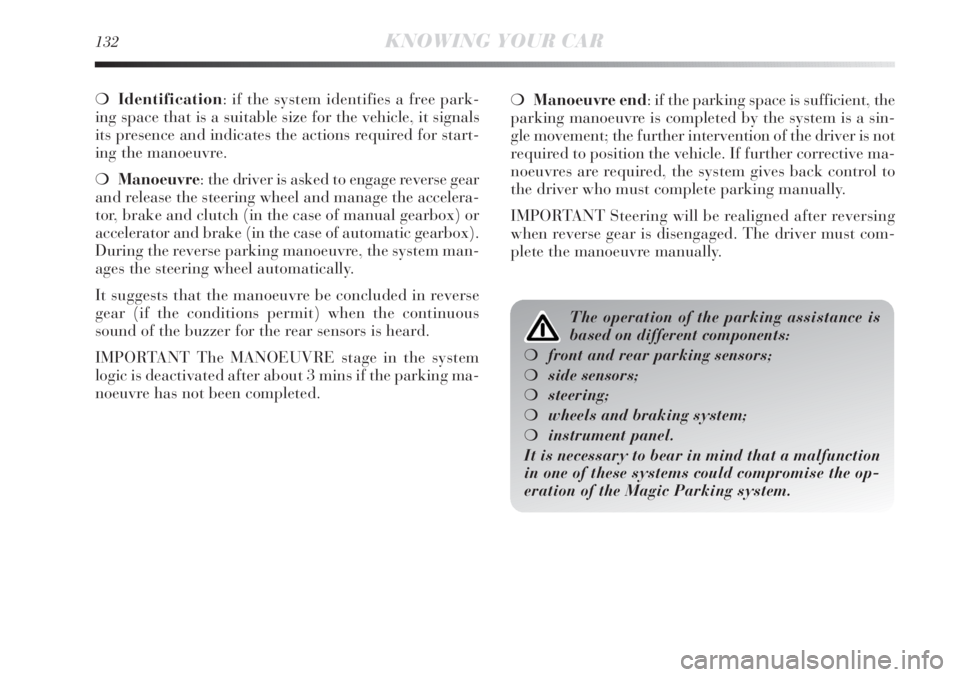
132KNOWING YOUR CAR
❍Identification: if the system identifies a free park-
ing space that is a suitable size for the vehicle, it signals
its presence and indicates the actions required for start-
ing the manoeuvre.
❍Manoeuvre: the driver is asked to engage reverse gear
and release the steering wheel and manage the accelera-
tor, brake and clutch (in the case of manual gearbox) or
accelerator and brake (in the case of automatic gearbox).
During the reverse parking manoeuvre, the system man-
ages the steering wheel automatically.
It suggests that the manoeuvre be concluded in reverse
gear (if the conditions permit) when the continuous
sound of the buzzer for the rear sensors is heard.
IMPORTANT The MANOEUVRE stage in the system
logic is deactivated after about 3 mins if the parking ma-
noeuvre has not been completed.❍Manoeuvre end: if the parking space is sufficient, the
parking manoeuvre is completed by the system is a sin-
gle movement; the further intervention of the driver is not
required to position the vehicle. If further corrective ma-
noeuvres are required, the system gives back control to
the driver who must complete parking manually.
IMPORTANT Steering will be realigned after reversing
when reverse gear is disengaged. The driver must com-
plete the manoeuvre manually.
The operation of the parking assistance is
based on different components:
❍front and rear parking sensors;
❍side sensors;
❍steering;
❍wheels and braking system;
❍instrument panel.
It is necessary to bear in mind that a malfunction
in one of these systems could compromise the op-
eration of the Magic Parking system.
Page 135 of 290

134KNOWING YOUR CAR
❍parking space longer than 130 cm compared to the
vehicle dimensions:parking in more than one manoeu-
vre, where only the first one can be carried out by auto-
matic steering management (the subsequent manoeuvres
are entirely the responsibility of the driver).
To select the search and manoeuvring side, the driver
must:
1)
DChoose to carry out the search for the space and the
manoeuvre on the passenger side with:
❍the direction indicator in the middle position;
❍the hazard warning lights on;
❍the hazard warning lights on and the direction indi-
cator in the passenger side position;
❍the direction indicator pointing towards the passen-
ger side.
2)
FChoose to carry out the search for the space and the
manoeuvre on the driver’s side with:
❍the direction indicator in the driver’s side position;
❍the hazard warning lights on and the direction indi-
cator in the driver side position;
The system will notify the driver, on the side in which the
search and the manoeuvre are taking place by means of
dedicated messages in the instrument panel display and
the symbol (
Fand
D) different on the right and left sides. The search will, however, take place on both sides, there-
fore it is possible to make the selection using the direc-
tion indicators even when having just driven past a park-
ing space that is deemed suitable.
During the search step, speed should not exceed 30 km/h;
when 25 km/h have been reached, the driver is asked to
decrease the speed; if the speed of 30 km/h is exceeded,
the system is disabled; in this case, the system must be
restarted by pressing the button A-fig. 82.
If the Lane crossing function is activated (see “Exterior
lights” paragraph) the search for the parking space al-
ways takes place on the passenger side.
If the parking sensors are activated during the search for
a parking space (see “Front and rear parking sensors”
paragraph), the operation of the Magic Parking system is
deactivated.
The search for the parking space and the
parking manoeuvres must be made in com-
pliance with the regulations in force of the
Highway Code.
Page 136 of 290
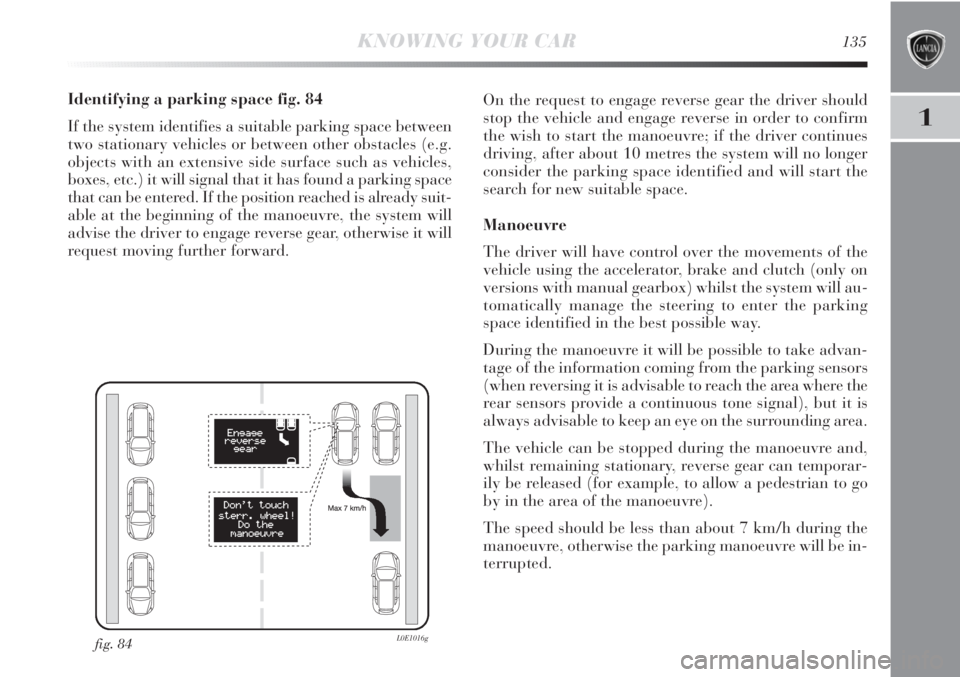
1
KNOWING YOUR CAR135
Identifying a parking space fig. 84
If the system identifies a suitable parking space between
two stationary vehicles or between other obstacles (e.g.
objects with an extensive side surface such as vehicles,
boxes, etc.) it will signal that it has found a parking space
that can be entered. If the position reached is already suit-
able at the beginning of the manoeuvre, the system will
advise the driver to engage reverse gear, otherwise it will
request moving further forward.On the request to engage reverse gear the driver should
stop the vehicle and engage reverse in order to confirm
the wish to start the manoeuvre; if the driver continues
driving, after about 10 metres the system will no longer
consider the parking space identified and will start the
search for new suitable space.
Manoeuvre
The driver will have control over the movements of the
vehicle using the accelerator, brake and clutch (only on
versions with manual gearbox) whilst the system will au-
tomatically manage the steering to enter the parking
space identified in the best possible way.
During the manoeuvre it will be possible to take advan-
tage of the information coming from the parking sensors
(when reversing it is advisable to reach the area where the
rear sensors provide a continuous tone signal), but it is
always advisable to keep an eye on the surrounding area.
The vehicle can be stopped during the manoeuvre and,
whilst remaining stationary, reverse gear can temporar-
ily be released (for example, to allow a pedestrian to go
by in the area of the manoeuvre).
The speed should be less than about 7 km/h during the
manoeuvre, otherwise the parking manoeuvre will be in-
terrupted.
fig. 84L0E1016g